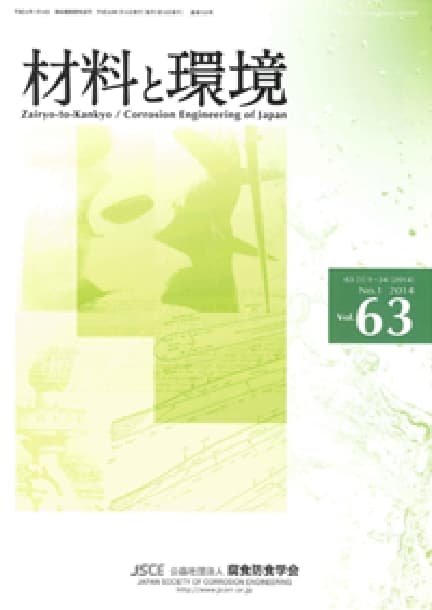- TOP
- Zairyo-to-Kankyo
- Vol. 72 (2023), No. 7
Zairyo-to-Kankyo Vol. 72 (2023), No. 7
Backnumber
-
Vol. 74 (2025)
-
Vol. 73 (2024)
-
Vol. 72 (2023)
-
Vol. 71 (2022)
-
Vol. 70 (2021)
-
Vol. 69 (2020)
-
Vol. 68 (2019)
-
Vol. 67 (2018)
-
Vol. 66 (2017)
-
Vol. 65 (2016)
-
Vol. 64 (2015)
-
Vol. 63 (2014)
-
Vol. 62 (2013)
-
Vol. 61 (2012)
-
Vol. 60 (2011)
-
Vol. 59 (2010)
-
Vol. 58 (2009)
-
Vol. 57 (2008)
-
Vol. 56 (2007)
-
Vol. 55 (2006)
-
Vol. 54 (2005)
-
Vol. 53 (2004)
-
Vol. 52 (2003)
-
Vol. 51 (2002)
-
Vol. 50 (2001)
-
Vol. 49 (2000)
-
Vol. 48 (1999)
-
Vol. 47 (1998)
-
Vol. 46 (1997)
-
Vol. 45 (1996)
-
Vol. 44 (1995)
-
Vol. 43 (1994)
-
Vol. 42 (1993)
-
Vol. 41 (1992)
-
Vol. 40 (1991)
Keyword Ranking
02 Jan. (Last 30 Days)
Zairyo-to-Kankyo Vol. 72 (2023), No. 7
Evaluation of Influence Factors for Galvanic Corrosion Coupled between Carbon Fiber Cloth and Carbon Steel
Muye Yang, Shigenobu Kainuma, Wenxuan Niu, Jiajing Xie
pp. 202-211
DOI:
10.3323/jcorr.72.202Abstract
Carbon fiber-reinforced plastic (CFRP)-strengthened steel structures are susceptible to galvanic corrosion, especially in high-humidity and marine environments. This study evaluated the key factors influencing galvanic corrosion coupled between carbon fiber and common steel. These factors include the specific electrochemical properties of unidirectional carbon fiber (CF) materials, contact mode between dissimilar materials, and environmental temperature. The results reveal that the carbon filaments and tows were considered physically homogeneous resistors in the fiber direction. However, the surface resistance drops significantly when the CF cloth is in flat contact with a rough conductive metal surface because of the optimized conductive path and enhanced electric contact area. Moreover, based on the Arrhenius equation, this study has developed a simplified model to explain the acceleration effect of temperature on CF-steel galvanic corrosion. It was found that galvanic corrosion is more sensitive to temperature changes than the corrosion of common steel.
Article Access Ranking
02 Jan. (Last 30 Days)
-
Delayed Fracture Mechanism of 1700 MPa-Class Quenched and Tempered Bolt under Atmospheric Corrosion Environment
Tetsu-to-Hagané Advance Publication
-
Perspectives on the Promising Pathways to Zero Carbon Emissions in the Steel Industry toward 2050
ISIJ International Vol.65(2025), No.2
-
Effect of B on Surface Oxidation Behavior and Phosphatability of Si-Mn-added Cold-Rolled Steel Sheets
ISIJ International Advance Publication
-
Factors Influencing the Bonding Phase Structure of Iron Ore Sinters
ISIJ International Vol.43(2003), No.9
-
Abnormal Grain Growth Behavior of Ferrite in Pure Iron with Cold Torsion
Tetsu-to-Hagané Advance Publication
-
Prussian blue as a fully reversible hydrogenochromic material for visualizing hydrogen distribution in Fe sheet
ISIJ International Advance Publication
-
From plasticity to fracture in pearlitic microstructures: Atomistic study of cementite thickness and deformation localization
ISIJ International Advance Publication
-
Influence of Antimony on the Oxidation Characteristics of 65Mn Steel
ISIJ International Advance Publication
-
Growth, Removal, and Agglomeration of Various Type of Oxide Inclusions in Molten Steel
ISIJ International Advance Publication
-
Steel Cleanness Evaluation: Framework for Inclusion Characterization by Means of Automated and Manual SEM/EDS Analysis and Computational Thermodynamics
ISIJ International Vol.65(2025), No.13
You can use this feature after you logged into the site.
Please click the button below.










